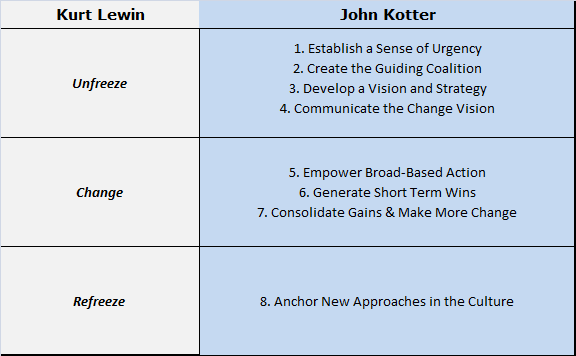In This Article
(Click the links below to move easily to sections of this article)What is Lewin’s Change Model
Reconciling Lewin’s and Kotter’s Change Models
Using Lewin’s Model in Organizational Change Efforts
Video: Understanding Kurt Lewin’s 3-Step Change Model
Scholarly Citations for this Article
Member Content
- Article: Understanding the Bad, the Good, and Your Role in Change and Innovation
- Video: Improving Your Ability to Lead Change
- Self-Assessment: How Effective Are You as a Change Agent?
- Lesson: How to Communicate the Need for Change
- Lesson: How to Reduce Employee Resistance to Change
- Gold and Silver Tier Bonus: Infographic Cheatsheet Questionnaire — Is Your Organization Ready for Change?
- Gold Tier Bonus: Special Report — 5 Strategies to Build Support for Organizational Change
What is Lewin’s Change Model

These three words are not a child’s game however. Instead, unfreeze, change, and refreeze describe Kurt Lewin’s powerful and simple three-step change model (change as three steps or CATS model).
Lewin’s work on organizational change is well known in college business courses and among organizational development professionals. In other discussions, however, it is less frequently mentioned in favor of other change models such as John Kotter’s, Eight Step Leading Change Model.
I like Lewin’s model and it is helpful in explaining the change process, particularly when it is combined with other models like Kotter’s. In this article, I will first describe the Lewin model and then show how you can use it with Kotter’s model to make a thoughtful case for planned change.
Lewin's 3 steps for leading change are unfreezing the organization, implementing change, and refreezing. Click To TweetKurt Lewin (1890 – 1947) was a psychologist. He is often called the father of modern social psychology. He suggested that change requires three steps: unfreezing the organization, implementing the change, and refreezing the organization1.
The first step of unfreezing involves convincing those that are affected by the change that the change is indeed necessary. Once the affected stakeholders have accepted the need for change, the next step of Lewin’s model is to implement it. The last step after implementation of the change is to take actions to reinforce and support it so that the change becomes a permanent way of doing business.
This is the beauty of Lewin’s model: it is simple consisting of three steps. First, convince the organizational stakeholders that the change you propose is necessary, make the change, and then make it a permanent way of doing business.
Reconciling Lewin’s and Kotter’s Change Models
Sounds great, but in today’s modern workplace the Lewin model alone is simplistic. This is where Kotter’s model can be used in combination with Lewin’s model to convince senior leadership of the need for an orderly process for instituting organizational change.
John Kotter’s model is compatible with Kurt Lewin’s model and is in reality an extension of it (like all social progress that builds on the work of earlier pioneers). As shown in the following chart, Kotter’s eight steps for leading change are aligned with Lewin’s model as follows:

Using Lewin’s Model in Organizational Change Efforts

Specifically, it is very effective when used as a strategic communication tool. The key is to use the Lewin model in combination with the Kotter model.
When combining the models, language is important. A useful approach is to describe the steps of the Lewin model as phases and then explain the corresponding Kotter steps for each phase.
For example, when explaining that the first phase of the change effort is to unfreeze the organization, you would explain to senior leadership that they will need to sponsor four critical activities in this first phase:
- Establish a sense of urgency;
- Create the guiding coalition;
- Develop a vision and strategy; and
- Communicate the change vision.
The remaining two “phases” of Lewin’s model can also be aligned with the corresponding steps of the Kotter model to explain an orderly process for change. While it is not necessary to combine the models, it can be useful in keeping others on task on the change management journey.
For example, if various forces in the organization are too impatient for change and push for working on short-term wins when the organization has still not communicated the change vision, it’s often simpler to communicate with the Lewin model as follows: We need to finish unfreezing the organization before we implement the change.
Kurt Lewin’s, Three Step Change Model, has a rightful place in the discussion of how to lead change in modern organizations. It just needs “some tweaking” to account for the organizational complexity of our time.
Note: There is a question whether Kurt Lewin actually fully developed this three step model before his death or whether others built this model based on some of Lewin’s previous work. To learn more, you can do a Internet search on the origins of the CATS theory.
To get others to support you in your effort to make change, you will first have to convince them that change is necessary. Click To TweetVideo: Understanding Kurt Lewin’s 3-Step Change Model
Scholarly Citations for this Article
This article from Management is a Journey has been cited in the following scholarly research articles:
- Thesis: Raising Environmental Awareness and Behavior in and by Project Management | Uppsala University (Peter Hedberg and Peter Jonsson)
- Dissertation: A Phenomenological Study of Teachers Implementing Restorative Practices | Liberty University (Janiese Pauline McKenzie)
This article is accurate to the best of the author’s knowledge.
Content is for informational or educational purposes only and does not substitute for professional advice in business, management, legal, or human resource matters.